As schools and colleges evolve to changing conditions, they are faced with questions about how to sustain and strengthen their resources, their community, and the environment. At Perkins&Will, the concept of stewardship means planning for a future that helps institutions protect, cultivate, and support the resiliency of all three. This means planning facilities that continue to support goals and activities as they evolve.
We help academic institutions determine how to retain their greatest assets, while continuing to prosper in learning, research, and as steward and responsible citizen. We understand the issues of: doing more with less; the importance of place; the essence of partnership, collaboration, connectivity, and engagement; stewardship – of place, finances, and community; and of learning – the evolving nature of education.
1. Doing More with Less
We increasingly see institutions having to do more with less in the face of reduced public funding, the stresses of enrollment growth, a shifting focus on learning outcomes, and changing demographics with increasing diversity. At the same time, students require a wider range of learning experiences with integrated technology.
Existing buildings that are outmoded, lack current technology, and are inefficient in the use of space are a burden and need to be addressed. We work with our clients to help them make strategic decisions that make the most out of opportunities to improve existing facilities and when designing new, to design flexible, loose fit buildings that anticipate the future.
Adaptive re-use is one of the most sustainable strategies available to us today.åÊ When appropriately planned, the repurposing of an existing building can support a university’s sustainability goals and reduce capital costs.
Blurring traditional program boundaries strengthens the co-curricular student experience by bridging the educational spectrum from formal teaching to informal learning spaces. When traditional academic programs are successfully combined with co-curricular programs, new opportunities for hybrid strategies in finance and operations become available.
2. The Importance of Place
With greater opportunities for on-line learning, your place-based campus becomes even more important to student, faculty, and staff experiences. Your campus must be a place where your community most thrives, feels at home, and experiences connection to your institution.
The physical campus, both buildings and spaces, gives form to the values, history, and traditions of the institution and provides the setting for the student experience – intellectual and social. We acknowledge, explore, enhance, and celebrate the specific qualities of each campus to reinforce your mission, values, and unique sense of place.
Creating a lasting beacon of institutional values can be an important tool in student recruitment and retention. These buildings are literally the bricks and mortar representation of how an institution regards its students and clearly communicate the institution’s “DNA” – its collective stories and brand message. The best and most active university facilities offer a “window”, both figuratively and literally, into the range of services, programs, and activities available campus wide.
3. Partnership. Collaboration. Connectivity. Engagement
At the heart of learning is collaboration, connection, and engagement. Developing deliberate ways to collaborate between disciplines and constituents has become increasingly imperative. Schools and universities are essential environments which bring together faculty, staff, and students formally and for invaluable “casual collisions” outside of the classroom.
We design learning spaces where these deliberate collaborations can happen, but we also look for opportunities for casual engagement in hallways, residence halls, student centers, recreation facilities, and in the open spaces of the campus.
Often collaboration encompasses external partnerships with businesses, agencies, and associations to expand learning, research, and collaboration opportunities. The trend toward public/private development is an extension of these partnerships and has helped institutions meet facility needs that otherwise would not have been possible. Our practice includes professionals seasoned in public/private development who can work with you and your partners effectively and efficiently with a proven approach and many lessons learned.
4. Stewardship: Place. Finances. Community
Thomas Jefferson said, “Every generation needs a revolution.” For today’s students that revolution just might be sustainability.
Campus stewardship demands sustaining the campus in all of its dimensions – physical, social, and economic – for long-term vibrancy and resiliency. To maintain long-term viability, these facilities must support the social fabric of the campus community where they are located and provide an economically feasible service platform for decades to come.
Only at the point where environmental impact is reduced to zero do buildings become truly sustainable. The next wave of environmentally-conscious design goes beyond merely reducing negative impacts to buildings that positively contribute to the environment through regenerative design. Tomorrow’s buildings will generate more power than they consume, harvest more water than they use, and become inseparably connected with their local ecosystems.
5. Learning: Designing for the Changing Nature of Education
Recent advances in brain science and learning research have revealed striking insights into how we learn. It is now understood that there are many ways to acquire knowledge, and individuals respond differently. The ‘digital-native’ generation in particular has developed unique modes of assimilating and comprehending information. Learning space design has evolved alongside these changes.
Our planning and design strategies support this fluid environment where pedagogy, technology, and new ideas are continually evolving and blurring traditional boundaries. Flexible and adaptable environments must support the dynamic nature of teaching and learning; spaces must foster collaboration, serendipitous encounters, and “productive collisions.”
Our practice covers the full suite of learning space-types from active, problem-based environments to adaptive learning and use of the latest technology for hybrid curricula, instant feedback, and immersive simulation environments. The key to designing spaces is providing flexibility for the future advancements, while supporting current understanding of how best to support learning intentions and outcomes.

















